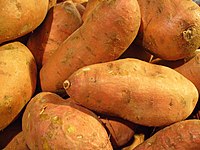
Photo from wikipedia
Abstract An 8-week feeding trial was conducted to establish the optimal dietary vitamin E requirement for juvenile yellow drum (Nibea albiflora). Fish (initial weight 32.32 ± 0.26 g) were fed six diets containing… Click to show full abstract
Abstract An 8-week feeding trial was conducted to establish the optimal dietary vitamin E requirement for juvenile yellow drum (Nibea albiflora). Fish (initial weight 32.32 ± 0.26 g) were fed six diets containing graded levels of vitamin E (α-tocopherol) (0, 20, 40, 80, 160 and 320 mg kg−1). The levels of dietary vitamin E, analyzed by high-performance liquid chromatography, were 4.0, 15.4, 36.2, 69.4, 137.9 and 292.7 mg vitamin E kg−1 diet. Weight gain and specific growth rate were significantly higher in fish fed the 69.4 mg kg−1 diet than in fish fed the 4.0 mg kg−1 diet. Among all diet treatments, the feed conversion ratio was the lowest and the protein efficiency ratio was the highest in fish fed the 69.4 mg kg−1 diet. The whole-body lipid content of fish fed the 292.7 mg kg−1 diet was significantly lower than that of fish fed the 4.0 mg kg−1 diet. Liver vitamin E concentration increased with dietary vitamin E levels up to 137.9 mg kg−1 diet, and plateaued thereafter. Fish fed the 36.2 mg kg−1 diet had significantly higher serum superoxide dismutase activity than fish fed the 137.9 mg kg−1 diet. The level of serum malondialdehyde was significantly lower in fish fed the 36.2 mg kg−1 diet than in fish fed the 4.0 mg kg−1 diet; fish fed the 292.7 mg kg−1 diet had significantly higher lysozyme activity than fish fed the 4.0–69.4 mg kg−1 diets. Subsequently, a challenge test by injection of Vibrio alginolyticus showed significantly higher cumulative mortality among fish fed the 292.7 mg kg−1 diet as compared with those fed the 15.4–69.4 mg kg−1 diets. This study demonstrated that proper dietary vitamin E could enhance growth performance, antioxidant status, and ability against bacterial infection in yellow drum juveniles. A broken-line model of percent weight gain indicated the optimal vitamin E requirement for juvenile yellow drum is 68.75 mg kg−1.
Journal Title: Aquaculture
Year Published: 2019
Link to full text (if available)
Share on Social Media: Sign Up to like & get
recommendations!